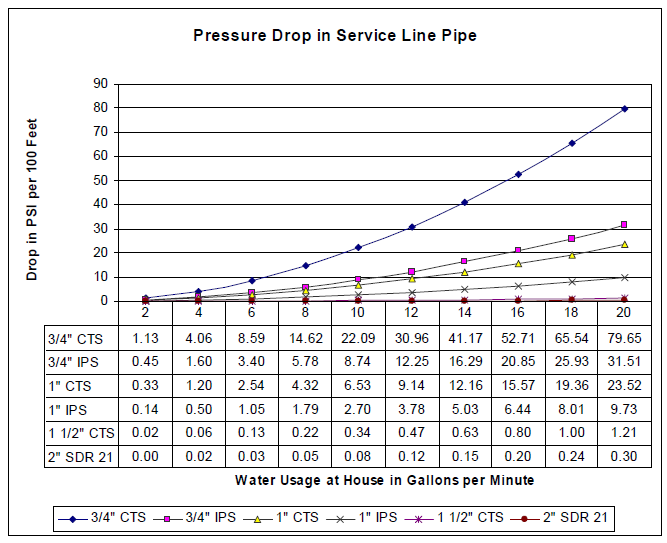Selecting a Service Line
While the service line between our meter and the house belongs to the customer and is their responsibility, we are often asked for help in selecting the type and size line to use. This guide answers most of the commonly asked questions.
The water pressure you experience in your house is a function of three parameters:
- The static pressure in the water. This is measured as the vertical distance between the water in our elevated tank and the elevation of the main line at your property. The higher your property in elevation, the lower your pressure. The static pressure in our system ranges from 35 to 90 PSI. Your static pressure depends on your elevation. Static pressure is a fixed parameter and cannot be changed.
- The amount of water you are trying to use at one. As water moves through a pipe, friction is generated between the water and the pipe wall. This results in a drop in pressure. The greater the quantity of water that moves through the pipe, the greater the pressure drop. If you have turned on several water devices at the same time such as lawn sprinklers, a washing machine, a dish washer and a shower you may notice that when you open the kitchen faucet you don’t get as much water as you normally would. People often mistake this as a problem of low pressure in the water main. However, the pressure at the main line is essentially the same. The low pressure you experience at your faucet is a result of the large quantity of water moving through your service line.
- The size of your service. The size of your water line also affects the pressure drop between the main line and your house. Larger diameter service lines will have less pressure drop.
Del-Co recommends that you use the following service line material for most residential installations:
- 1-inch Iron Pipe Size (IPS) polyethylene (PE) pipe, SDR 7
It has been our experience that using a smaller diameter service line may result in lower than desired water pressure if the customer is using several water devices at the same time.
Houses that are set back more than 500 feet from the water main should consider using a larger service line. Two options that Del-Co recommends are:
- 1 1/2-inch Copper Tube Size (CTS) polyethylene (PE) pipes, or
- 2-inch SDR 21 PVC
These are both commonly used pipe materials that result in less pressure drop. Polyethylene pipe is available in up to 400-foot rolls so there are fewer joints. However, we recommend that if you do need a joint you use a brass compression coupling, not a barbed insert, to make the connection. PVC pipe is available in 20-foot lengths and has a push-on joint connection. We have found both to be good pipe when installed properly.
The graph below compares pressure drop in various types of service line pipe.
Call our Engineering Department if you have any questions.

